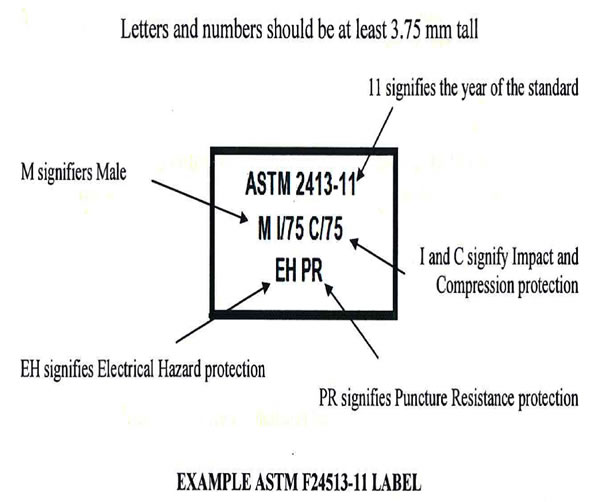ASTM (American Society for Testing and Materials) 2413 sets the minimum standards and testing procedures for safety footwear.
The identification of the ASTM 2413 standard is:
- LINE 1 – ASTM F2413-11 (The F2413 identifies the ASTM Standard and the “11” signifies the year of the standard)
- LINE 2 – F (Female) or M (Male) and I/75 (Impact safety-toe protection) and C/75 (Compression safety-toe protection)
- LINE 3 – Used to reference additional protective features and they should appear in the order that they appear in the standard, i.e. Mt, Cd, EH, SD, PR.

Every year, thousands of work place injuries occur that could have been prevented with the right gear. Safety work boots are tested according to ASTM 2413 standards for impact and compression safety-toe resistance, metatarsal protection, conductivity resistance, electrical shock resistance, static dissipative properties, and puncture resistance. Below is a guide to help understand what exactly ASTM is and how safety footwear is tested.
Impact ( I ) and Compression ( C ) Resistance
A safety test is performed by dropping a 50 pound weight from a predetermined height (1.5 feet) at a designated speed. The I/75 C/75 rated footwear will protect the wearer’s toes from an impact of up to 75 foot-pounds and compressive loads up to 2,500 pounds.
The clearances under the safety toe after the test is performed are as follows:
- Men-0.500 Inch (12.7mm)
- Women-0.468 Inch (11.9mm)
*The standard doesn’t cover the use of ‘aftermarket add-on’ protective toe devices*
Metatarsal – MT
Metatarsal protection is designed to prevent or reduce injuries when the toe and metatarsal areas of the foot are exposed to hazards. The metatarsal test is performed by dropping a 50 pound weighted bar 1.5 feet onto the metatarsal guard. (75 foot-pounds of impact energy.) The impact energy is the same as for the safety- toe impact. The clearance is measured by inserting a wax foot-form into the shoe to accurately measure the deflection of the metatarsal guard on the interior of the shoe.
The clearances under the metatarsal guard after the metatarsal impact are as follows:
- Men- 1 Inch (25.4mm)
- Women-0.937 Inch (24mm)
*The standard doesn’t cover the use of ‘after market add-on’ guards*
Conductive Footwear- CD
Conductive footwear is designed to discharge static electricity from a person’s body through their shoes to the ground. This type of footwear is designed to minimize static electricity and take the “charge” out of your body so static discharge sparks do not occur.
The electrical resistance of conductive protective footwear should range between 0 and 500,000 ohms. (One-half Mega Ohm)
Electrical Shock Resistant Protection- EH
EH protective footwear is designed to reduce the hazards due to accidental contact with live electrical circuits and is only meant to be used as a secondary protection for electrical hazard environments.
The outer surface of the sole and heel shouldn’t be penetrated by any electrically conductive component, like nails in the heel.
EH shock resistant footwear must be capable of withstanding the application of 18,000 volts at 60 Hz for 1 minute with no current flow or leakage in excess of 1.0 milliampere.
Static Dissipating Footwear-SD
SD protective footwear is designed to reduce the buildup of excess static electricity by conducting body static charge to ground, while maintaining a sufficient high level of resistance that protects the wearer from electrical hazards due to live electrical circuits.
The electrical resistance must be greater than 1,000,000 ohms (1 Mega Ohms) and not exceed 100,000,000 ohms (100 Mega Ohms).
Sole Puncture Resistant Footwear – PR
Puncture resistant footwear includes a sole puncture resistant device (usually below the insole) which reduces the possibility of puncture wounds to the bottom of the feet.
PR footwear should withstand a minimum nail penetration force of 270 pounds.
